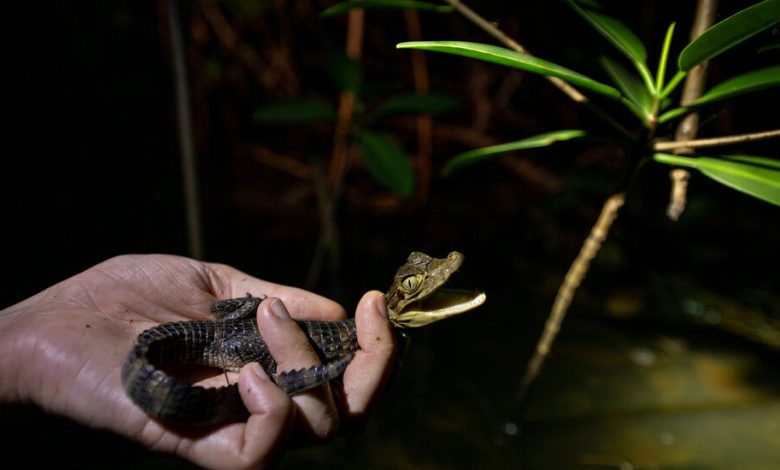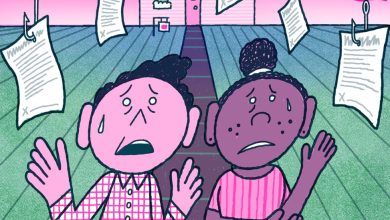See You Later, Not-an-Alligator

Sidney Godfrey was sitting in the passenger seat of a truck slowly cruising over a levee one night in 2018. This far into Florida’s dry season, the air was thick with the smell of mud wafting up from the exposed canals and wetlands along the edge of Biscayne Bay, south of Miami. Mr. Godfrey, a wildlife biologist, kept his gaze — and his headlamp — pointed down to light up the water at the base of the levee.
The glint of a reptilian eye came from a grove of Australian pine below. The hunt was underway.
It was Mr. Godfrey’s first night surveying with the Croc Docs — the nickname for a University of Florida lab based out of Fort Lauderdale. He and Ed Metzger, that evening’s survey leader, stepped out of the truck and started making their way down to the target. They soon found themselves wading through muck. Their legs punched through layers of pine needles mixed with mud. Each step dredged up the smell of dead and decaying things.
The owner of the shining eyes had spotted the pair and was doing his best to move away from the lumbering humans. But the researchers persisted, slowly, painfully, wading toward an animal that was neither a trademark Florida gator nor a native crocodile. Their quarry was instead a six-foot-long spectacled caiman.
The caimans of southern Florida are not as well known as their alligator cousins. Half a century ago, caimans were taken from their homelands in tropical wetlands of Latin America and brought to the United States for the leather and pet trades. Most of the hundreds of thousands of caimans imported into the United States during the 1970s perished. But a few held out in the southernmost corner of the Sunshine State. Like many invasive species in Florida, they’ve become a nuisance.
Scientific understanding of the effects of invasive caimans is still evolving. But researchers have spotted signs that caimans might crowd out American alligators and American crocodiles, while preying on vulnerable indigenous species. And the animals are more aggressive when cornered than native crocodilians, potentially putting people at risk of attacks.

Bryan Daykin, a member of the Croc Docs, near Homestead, Fla. The group used to find dozens of spectacled caimans each year in areas of South Florida, but their numbers have been falling.Credit…Jason Gulley for The New York Times
Over the last decade, the Croc Docs have run surveys across Miami-Dade County in an attempt to understand the lives of these elusive predators. This isn’t idle curiosity. By learning about caimans, the lab has been working to bring their numbers under control. It’s a goal shared with state and federal agencies, including the U.S. Fish and Wildlife Service.
And it’s a goal that may be attainable. The crew has spotted fewer and fewer caimans along survey routes in recent years. In a study published this August, the researchers found that the area’s caiman populations might be on the decline. If so, the caiman could become one of the few invasive species that Florida manages to get rid of, or at least get under control.
Mr. Godfrey has had that possibility in mind ever since that first night in 2018. After chasing the caiman through the brush, Mr. Metzger was able to wrangle a snare around its snout. When the beast tired itself out, the two men made the return journey back to the truck, caiman in tow.
The rush of the capture “kind of got me hooked,” Mr. Godfrey recalled. It was a life-altering moment.
Two months later, he was head surveyor for the caiman project.
Home on the Base
The story of how caimans came to the United States starts with alligators.
Americans developed a taste for alligator leather in the 1800s. Millions of the animals were slaughtered to meet the growing demand for alligator hide. By the 1960s, their numbers had declined so precipitously that Southern states began limiting or banning the alligator trade. Then, alligators received federal protection in 1967.
The leather industry pivoted to harvesting the ample supply of caimans in the tropical wetlands of Central and South America. Savvy businesspeople soon brought live caimans stateside. Over 112,000 caimans were imported in 1970 alone, according to a Fish and Wildlife Service estimate.
From there, some animals were set up on farms to be raised for leather. But hatchlings were also sold at gas stations and grocery stores as pets. Most of the caimans sold in stores were spectacled caimans — a species so named for the glasses-like ridge that runs along their snouts. These reptiles are somewhat smaller than crocodiles native to Florida. But telling them apart from alligators and crocodiles can still be tricky for those who haven’t developed an eye for their gray, yellow and chocolate-brown splotches or their distinctive ridgeline.
The Air Force base in Homestead, Fla., just south of Miami, is often considered the epicenter of the caiman invasion. No one knows exactly how caimans first arrived on the base. One possibility is that servicemen stationed at the base were among the many Floridians who kept the reptiles as pets. When those animals grew too big or the airmen were deployed elsewhere, they tossed them in the waterways surrounding the base (which probably also happened in other parts of Florida and the United States).
The temperatures around the base rarely dip below freezing, and a few of the caimans grew up. By 1974, Homestead was home to a healthy population.
The reptiles around the base made a nuisance of themselves by crawling onto the tarmac to bask in the sun or clambering up from the water to lounge near the planes. Military personnel worried an accident might happen if a plane hit a caiman while landing. So, in 1977, the base launched its first counteroffensive against the crocodilians.
A yearlong campaign succeeded in catching 40 adults, four hatchlings and a nest. But by then it was too late. The caimans had spread into nearby Biscayne Bay. Soon they would head north, eventually as far as Cape Canaveral and even to the eastern edge of Everglades National Park.
It appeared the caimans were here to stay.
Battle in the Canals
Jake Edwards, an invasive species biologist, can still remember the first time he saw the Honey Hole. In 2012, when he worked for the Florida Fish and Wildlife Conservation Commission, Mr. Edwards joined a survey of invasive Burmese pythons near Biscayne Bay, east of Homestead Air Reserve Base. The crew found their way to a marshy area filled with mangroves and directed their spotlight out into the water.
“It was like someone had turned on Christmas lights,” Mr. Edwards recalled.
The lights were dozens and dozens of caiman eyes. While it’s not unusual to find a caiman or two on surveys, Mr. Godfrey said, the Honey Hole was something else. “There were probably over 60 caimans in there,” he said. They named the coffee-colored waters the Honey Hole, after the slang term for a beehive that yields a lot of honey.
Biscayne Bay remains a hot spot. Of all the places Mr. Godfrey and his fellow Croc Docs patrol, this area has yielded the most caimans. Around the time the Honey Hole was discovered, people also started spotting caimans within the boundaries of Everglades National Park. And while their overall numbers remained low — somewhere in the low 100s — invasive species experts were growing worried about the caimans’ effect on native fauna.
Necropsies of euthanized caimans revealed that the reptiles attacked native turtle and snake species that are already struggling with habitat loss and road kills. Waters infested with caimans, such as the Honey Hole, also have a suspicious dearth of native crocodilians, which suggests that caimans are crowding out indigenous alligators and crocodiles. The Florida Fish and Wildlife Conservation Commission identified the caiman as a priority species for removal in 2012.
So, with help from the commission, the Croc Docs got to work. Almost every week since, whether it’s 40 degrees or a mosquito-ridden summer day, the researchers pick a night and search for caimans. Two-person teams head out at sundown, looking for the crystals in crocodilian eyes that reflect light in the dark, allowing researchers to spot the well-camouflaged reptiles. The team then uses a spotlight to distinguish caimans from native crocs and gators.
Catching caimans is a skill, and the Croc Docs have developed it with time and experience. Over 10 years, they have captured around 250 of the nearly 320 caimans they spotted during their surveys.
At just two feet long, juveniles can be snatched out of the water with one hand. Older animals tend to be savvier, ducking underwater when a member of the survey team creeps up. Then, it’s a game of waiting until they resurface, and hoping they don’t swim or run away underwater.
Creeping through the water to find a caiman, you can “sometimes get a little too close for comfort before you realize where they’re sitting,” Mr. Godfrey said. Even a caught caiman isn’t done fighting. Once, when Mr. Godfrey was demonstrating for a group of new hires the proper technique for handling a captured animal, the caiman he was sitting on tried to escape. He was dragged a few feet and got a nasty case of carpet burn.
The Croc Docs caught just five caimans in the first year. In 2020, the team set a record of 47. But their catch rate is now on the decline. In July, Mr. Godfrey took his team out to the Honey Hole, and the once-teeming pond seemed to host just a single juvenile caiman hiding in the mangroves.
Juveniles mean hatchlings. And hatchlings mean that there are still some caimans actively nesting in southern Florida.
On a Croc Doc survey last week, Bryna Daykin and Libby Sutton, wildlife biologists of the University of Florida, captured a caiman hatchling in a marsh near Biscayne Bay. The tiny foundling — so small the women could scoop it up by hand — means that there is at least one breeding pair in the area.
The decline in sightings by survey crews like Ms. Daykin and Ms. Sutton might mean that caimans are getting better at hiding. But there’s another, more tantalizing possibility: The patrols are working.
Art Roybal, a biologist with the U.S. Fish and Wildlife Service in Florida, suspects that the Croc Docs’ catch-and-kill technique is behind the decline.
“It’s not the most wonderful job,” he said. But the researchers “know their species really well,” he added.
The team euthanizes each captured caiman using a captive bolt gun — similar to a technique used to stun cows before they’re butchered. It’s a relatively humane way to kill the animals, and it ensures that they can’t return to the ecosystem to breed, Mr. Godfrey said.
Caimans are a good prospect for elimination because they’re prevented from moving too far north by the frost line. But nonnative animals have a bad habit of popping back up when you least expect it. So getting rid of the caiman for good will take more money — and that’s something Mr. Roybal says you can’t always count on.
“The funding is never there for invasive species,” he warned.
Joshua Friers, the cultural and natural resources manager for Homestead Air Reserve Base, was more optimistic. “I do think this is a species we can successfully eradicate,” he said. When Mr. Friers started working at the base 15 years ago, one of his responsibilities was to remove caimans that wandered too close to its buildings. He hasn’t spotted one in years.
And for what it’s worth, Mr. Godfrey noticed that in some of the areas where the team removed caimans — including near the Honey Hole — alligators and crocodiles had started to reappear. It’s hard to say for sure that removing an invasive species is helping the local ecosystem. But the return of native species is a good sign, he says.
The work by the Croc Docs lab is “an awesome success story,” Mr. Edwards said. Invasive species removal is tough, messy and slow work.
But “it’s worth it,” he said. “If nobody does it, we’re not going to have the Everglades. We’re going to have a zoo.”





